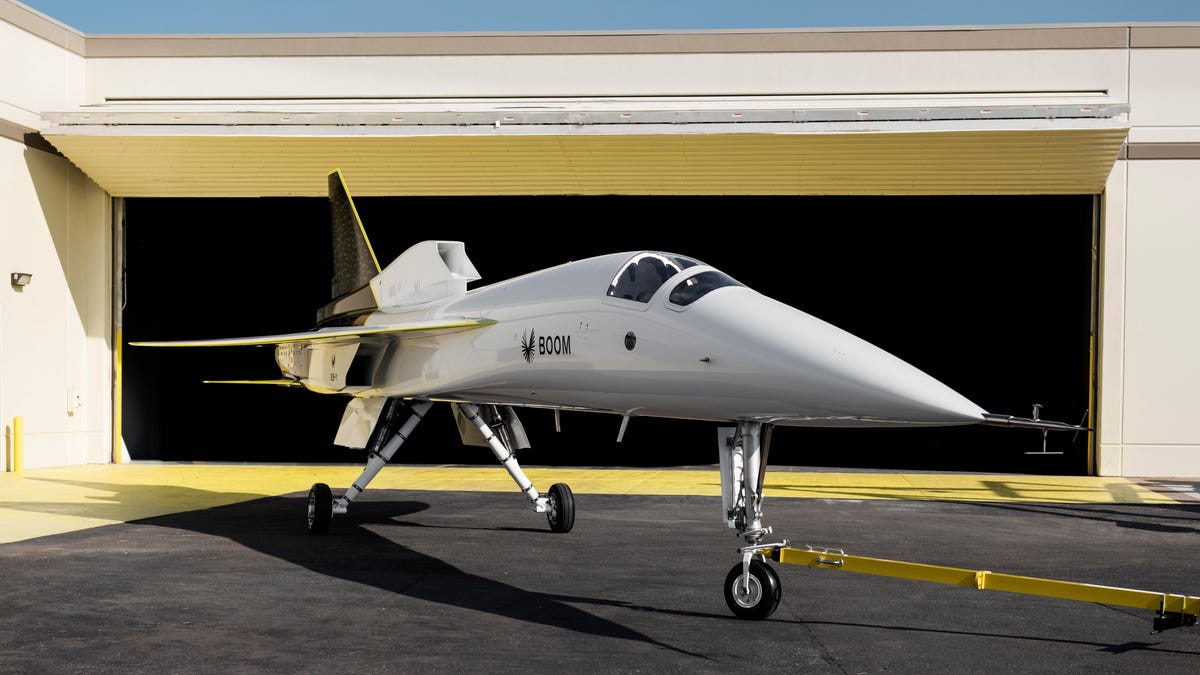Boom Supersonic wants you to break the sound barrier
The XB-1, unveiled Wednesday, will be a test aircraft for the company's planned commercial supersonic airplane.

Someday ordinary people might fly at supersonic speeds in this.
Boom Supersonic on Wednesday unveiled what it hopes to be the first step in letting ordinary people fly at supersonic speeds again. The XB-1 that rolled out at an event in Colorado won't carry passengers, but it'll serve as a demonstration aircraft to test the company's technologies.
"We have begun to pave the path of a mainstream supersonic future," said CEO Blake Scholl. "Today we stand on the precipice of a new age of travel."
The 71-foot XB-1 will use three General Electric engines with 12,000 pounds of thrust. As with the Concorde, a long pointy nose will obscure the view of the runway from the cockpit during landing, but cameras will take the place of the Concorde's dropping nose.
"[The XB-1's] fuselage is designed for speed minimizing drag and supersonic performance," Scholl said. "Its carbon composite airframe retains its rigidity and strength even under the temperatures of supersonic flight and its delta wind balances low-speed performance for take off and landing with high speed efficiency."
Boom's ultimate goal is to bring back commercial supersonic flight following the retirement of the Anglo-French Concorde in 2003. Its planned Overture airliner, which was first announced at the 2017 Paris Air Show, promises to carry between 45-55 passengers --half the capacity of the Concorde.
Flying at more than twice the speed of sound, it would cut the current flight time between London and New York in half to just 3 hours, 15 minutes and a reduce a typical 14-hour flight between Los Angeles and Sydney to 6 hours, 45 minutes.
More importantly, though, Boom promises the Overture will fix many of the drawbacks that plagued the Concorde. Though it still looks futuristic even a half a century after its debut, the Concorde was loud (and that's not even counting the sonic booms), had limited range and it guzzled fuel making it extraordinarily expensive to operate.
Boom says a lighter carbon fiber skin -- some of the hardware on the XB-1 will be 3D printed by a Silicon Valley company called Velo -- will make the Overture cheaper for both airlines and passengers by being more fuel efficient. Carbon fiber will also better handle the high temperatures generated from air friction while flying at supersonic speeds (that friction caused Concorde's fuselage to grow by almost a foot at faster-than-sound speeds).
The XB-1 has three General Electric engines.
The company also says its aircraft will produce a softer sonic boom and its engines are supposed to be quieter (thanks to no afterburners) and carbon neutral by using sustainable fuel.
High promises indeed, and Boom has a long road ahead. Even today it didn't delve into deep detail about the Overture's features like its engines, except to say that it's developing a custom medium bypass turbofan with Rolls-Royce.
"They'll be both quiet and super efficient," Scholl said.
Of course, the Federal Aviation Administration will have to certify the Overture before it can carry passengers, but Boom will eventually have to fly over a higher hurdle. Sonic booms are still illegal or severely restricted over most countries, a big factor that limited the Concorde's routes and its appeal to airlines. If Boom hopes to fly more than just overwater routes, it'll need to have those bans modified or overturned.
Boom counts Linked In founder Reid Hoffman as an investor and says it has interest from airlines including the Virgin Group. Speaking remotely during the event, Japan Airlines Chairman Yoshiharu Ueki said it's partnering with Boom on the Overture's development.
"We imagine supersonic travel to bring significant value to us, the aviation industry and to international passengers," he said. "Boom is empowering the next era of travel through supersonic travel."
Mike Bannister, the former chief Concorde pilot for British Airways, also made a remote appearance. "I've always believed there would be a supersonic successor," he said. "The overture will be that airliner."
But the company is not alone in helping paying passengers to break the sound barrier again. Spike Aerospace, Aerion Supersonic and Lockheed in partnership with NASA, are all working on low sonic boom aircraft to varying degrees.
Test flights of the XB-1 are to begin next year over California's Mojave Desert. If all goes well and Boom is able to clear regulatory barriers, the Overture is slated for a rollout in 2025 and an entry into service by 2029.

